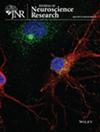James F. McGinnis, Philip L. Stepanik, Sutida Jariangprasert, Valentine Lerious
求助PDF
{"title":"恢复定位在多种视网膜细胞类型中的功能意义","authors":"James F. McGinnis, Philip L. Stepanik, Sutida Jariangprasert, Valentine Lerious","doi":"10.1002/(SICI)1097-4547(19971101)50:3<487::AID-JNR15>3.0.CO;2-3","DOIUrl":null,"url":null,"abstract":"<p>Knowledge of the cellular localization of recoverin in photoreceptor cells has enabled its interaction with other proteins to be postulated, tested and verified. Recoverin, a calcium sensing protein, is now thought to act by prolongation of the light state through interference with the interaction of arrestin and rhodopsin. Because of the detection of recoverin in multiple cell populations, the specificity of the cellular localization of recoverin was investigated in the retina of the mouse, rat, rabbit, chicken, frog, and chameleon and compared to that for opsin, phosducin, and arrestin. In addition to photoreceptor cell staining, the application of affinity-purified antibodies against recoverin demonstrated immunoreactive cells in the inner nuclear layer and a rare immunopositive cell in the ganglion cell layer of the mouse, rat and rabbit retina. Only photoreceptor cells were stained with recoverin antibodies in the chameleon and frog retina, whereas no cells were recoverin-positive in the chicken retina. In all six species studied, only photoreceptor cells were labelled with antibodies against opsin, phosducin or arrestin. Based on intensity of staining, two distinct populations of anti-recoverin-immunoreactive cells were distinguished in the photoreceptor cell layer of the retinas of the rat and rabbit, with the more darkly stained cells (probably cones) representing about 3% of the photoreceptor cells. The presence of recoverin in cells other than photoreceptors suggests it has an alternative or additional function and indicates the presence of multiple cell type-specific expression signals in the regulatory region of the recoverin gene. J. Neurosci. Res. 50:487–495, 1997. © 1997 Wiley-Liss, Inc.</p>","PeriodicalId":16490,"journal":{"name":"Journal of Neuroscience Research","volume":"50 3","pages":"487-495"},"PeriodicalIF":3.4000,"publicationDate":"1998-12-07","publicationTypes":"Journal Article","fieldsOfStudy":null,"isOpenAccess":false,"openAccessPdf":"","citationCount":"42","resultStr":"{\"title\":\"Functional significance of recoverin localization in multiple retina cell types\",\"authors\":\"James F. McGinnis, Philip L. Stepanik, Sutida Jariangprasert, Valentine Lerious\",\"doi\":\"10.1002/(SICI)1097-4547(19971101)50:3<487::AID-JNR15>3.0.CO;2-3\",\"DOIUrl\":null,\"url\":null,\"abstract\":\"<p>Knowledge of the cellular localization of recoverin in photoreceptor cells has enabled its interaction with other proteins to be postulated, tested and verified. Recoverin, a calcium sensing protein, is now thought to act by prolongation of the light state through interference with the interaction of arrestin and rhodopsin. Because of the detection of recoverin in multiple cell populations, the specificity of the cellular localization of recoverin was investigated in the retina of the mouse, rat, rabbit, chicken, frog, and chameleon and compared to that for opsin, phosducin, and arrestin. In addition to photoreceptor cell staining, the application of affinity-purified antibodies against recoverin demonstrated immunoreactive cells in the inner nuclear layer and a rare immunopositive cell in the ganglion cell layer of the mouse, rat and rabbit retina. Only photoreceptor cells were stained with recoverin antibodies in the chameleon and frog retina, whereas no cells were recoverin-positive in the chicken retina. In all six species studied, only photoreceptor cells were labelled with antibodies against opsin, phosducin or arrestin. Based on intensity of staining, two distinct populations of anti-recoverin-immunoreactive cells were distinguished in the photoreceptor cell layer of the retinas of the rat and rabbit, with the more darkly stained cells (probably cones) representing about 3% of the photoreceptor cells. The presence of recoverin in cells other than photoreceptors suggests it has an alternative or additional function and indicates the presence of multiple cell type-specific expression signals in the regulatory region of the recoverin gene. J. Neurosci. Res. 50:487–495, 1997. © 1997 Wiley-Liss, Inc.</p>\",\"PeriodicalId\":16490,\"journal\":{\"name\":\"Journal of Neuroscience Research\",\"volume\":\"50 3\",\"pages\":\"487-495\"},\"PeriodicalIF\":3.4000,\"publicationDate\":\"1998-12-07\",\"publicationTypes\":\"Journal Article\",\"fieldsOfStudy\":null,\"isOpenAccess\":false,\"openAccessPdf\":\"\",\"citationCount\":\"42\",\"resultStr\":null,\"platform\":\"Semanticscholar\",\"paperid\":null,\"PeriodicalName\":\"Journal of Neuroscience Research\",\"FirstCategoryId\":\"3\",\"ListUrlMain\":\"https://onlinelibrary.wiley.com/doi/10.1002/%28SICI%291097-4547%2819971101%2950%3A3%3C487%3A%3AAID-JNR15%3E3.0.CO%3B2-3\",\"RegionNum\":3,\"RegionCategory\":\"医学\",\"ArticlePicture\":[],\"TitleCN\":null,\"AbstractTextCN\":null,\"PMCID\":null,\"EPubDate\":\"\",\"PubModel\":\"\",\"JCR\":\"Q2\",\"JCRName\":\"NEUROSCIENCES\",\"Score\":null,\"Total\":0}","platform":"Semanticscholar","paperid":null,"PeriodicalName":"Journal of Neuroscience Research","FirstCategoryId":"3","ListUrlMain":"https://onlinelibrary.wiley.com/doi/10.1002/%28SICI%291097-4547%2819971101%2950%3A3%3C487%3A%3AAID-JNR15%3E3.0.CO%3B2-3","RegionNum":3,"RegionCategory":"医学","ArticlePicture":[],"TitleCN":null,"AbstractTextCN":null,"PMCID":null,"EPubDate":"","PubModel":"","JCR":"Q2","JCRName":"NEUROSCIENCES","Score":null,"Total":0}
引用次数: 42
引用
批量引用

 求助内容:
求助内容: 应助结果提醒方式:
应助结果提醒方式:


